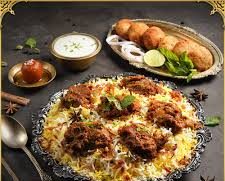Though typically regarded as a quintessentially South Asian dish with its epicenter in India, biryani is said to have first originated in Persia. The word biryani comes from the word “birian” which in the Persian language signifies being fried before being cooked.
Dum biryani is a slow cooked, layered rice dish and normal biryani is a kacchi biryani or pakki biryani. In normal biryani, the meat and rice are cooked separately before being combined. In terms of taste, dum biryani is often considered more flavorful and aromatic due to the slow cooking process.
Biryani is a celebratory rice and meat dish cherished in the Indian sub-continent. A traditional biryani consists of fluffy basmati rice layered over tender & succulent pieces of meat, accompanied with the mesmerizing aromas of spices, herbs & caramelized onions.
Boiled eggs do not turn hard or mushy in the cooked biryani since they are cooked in water. They absorb the flavors from the spices and herbs used.
This Egg Dum Biryani is best served with a Raita and if you want you may try out this Biryani Shorba/gravy. On the side this onion salad, kachumber or Indian cucumber salad goes well.
Egg biryani is a very healthy and nutritious food. The yolk contains 1.33 gm of cholesterol per 100 gm’s and is a rich source of vitamin A, B vitamins, calcium, phosphorous, lecithin and iron. Yolk has vital fat soluble vitamins A, E D, K.
Biryani also goes well with any Indian curry. Whether it’s the vegetables or meat in a vegetarian or non-vegetarian curry, when amalgamated with the rich flavour of biryani, it creates a culinary magic that is totally irresistible. The spices in both biryani and curry perfectly complement each other.
Salan. This creamy, slightly spiced and mildly tangy dish goes exceptionally well with a plate of your favourite Biryani. It is a curry-based item made of peanut, sesame and long-slit green chillies, and its mild taste blends perfectly with the richness of Biryani.















Reviews
There are no reviews yet.